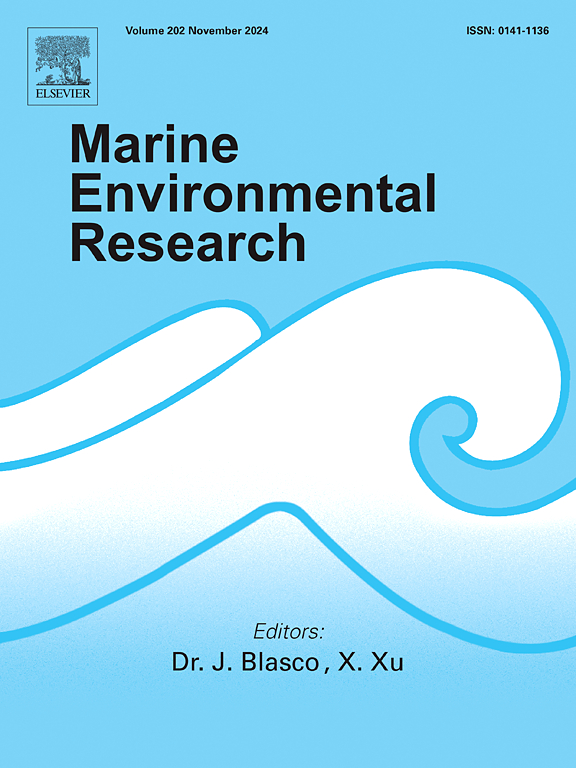潮间带软体动物对污染的生物标志物反应的调节作用
IF 3.2
3区 环境科学与生态学
Q2 ENVIRONMENTAL SCIENCES
引用次数: 0
摘要
潮间带是一个充满压力的环境,在那里生物必须对每个重现周期做出适应性反应。因此,在研究污染对潮间带生物的影响时,应考虑这一因素。然而,在相同的潮间带水平上,污染和重现时间对无脊椎动物的相互影响在很大程度上仍未被探索。本研究旨在探讨空气暴露时间对两种潮间带软体动物免疫和抗氧化生物标志物对污染的影响。在两个污染的港口(QQ和MDP)和参考点(RCT)采集不同浸出时间(0、2和4 h)的帽贝(Siphonaria lessoni)和贻贝(Brachidontes rodrigezii),测定其酚氧化酶(PO)、碱性磷酸酶(AP)、谷胱甘肽- s转移酶(GST)和过氧化氢酶(CAT)活性以及硫代巴比托酸活性物质(TBARs)水平。总的来说,暴露在空气中的个体对污染的生物标志物反应加剧,即使在最短的暴露时间(2小时)。相反,RCT中的帽贝和贻贝仅在回归4小时后才显示出酶活性的增加,这表明它们对回归应激的抵抗力更强,可能是由于更健康的环境。此外,空气暴露增加了来自受污染港口的帽贝(MDP为190%,QQ为300%)和贻贝(QQ为260%)的TBARs水平,而来自参考地点的生物体则没有这种变化。总体而言,受污染和未受污染地点之间的差异程度取决于所研究的大多数生物标志物/情况下生物重现期间收集的时间。因此,我们的研究结果强调了空气暴露时间如何混淆对污染的生化反应,强调了在评估受污染生态系统中潮间带生物的生理状态时考虑暴露时间的重要性。这些发现应该在多种环境和生物因素的更广泛背景下进行解释,这些因素共同影响了潮间带群落的污染反应。本文章由计算机程序翻译,如有差异,请以英文原文为准。
The role of emersion time in modulating biomarker responses to pollution in intertidal mollusks
The intertidal zone is a stressful environment where organisms must develop adaptive responses to each emersion cycle. Therefore, when studying the effects of pollution on intertidal organisms, this factor should be considered. However, the interactive effects of pollution and emersion time on invertebrates at the same intertidal level remain largely unexplored. This study aimed to investigate the influence of air exposure time on the immunological and antioxidative biomarkers of two intertidal mollusk species to pollution. Limpets (Siphonaria lessoni) and mussels (Brachidontes rodriguezii) were collected from two polluted harbor sites (QQ and MDP) and a reference site (RCT) at different emersion times: 0, 2, and 4 h. Biomarkers measured included phenoloxidase (PO), alkaline phosphatase (AP), glutathione-S-transferase (GST), and catalase (CAT) activities, as well as thiobarbituric acid reactive substances (TBARs) levels. In general, individuals exposed to air showed exacerbated biomarker responses to pollution, even at the shortest emersion time (2 h). Conversely, limpets and mussels from RCT showed increased enzyme activity only after 4 h of emersion, suggesting greater resistance to emersion stress, likely due to a healthier environment. Additionally, air exposure enhanced TBARs levels in limpets (>190 % in MDP; >300 % in QQ) and mussels (>260 % in QQ) from contaminated harbor sites, while organisms from the reference site showed no such changes. Overall, the magnitude of differences between polluted and unpolluted sites was dependent on the timing of organism collection during emersion for most of the biomarkers/situations studied. Thus, our results highlight how air exposure time can confound biochemical responses to pollution, emphasizing the importance of considering emersion duration when assessing the physiological status of intertidal organisms in polluted ecosystems. These findings should be interpreted within the broader context of multiple environmental and biological factors that collectively shape pollution responses in intertidal communities.
求助全文
通过发布文献求助,成功后即可免费获取论文全文。
去求助
来源期刊

Marine environmental research
环境科学-毒理学
CiteScore
5.90
自引率
3.00%
发文量
217
审稿时长
46 days
期刊介绍:
Marine Environmental Research publishes original research papers on chemical, physical, and biological interactions in the oceans and coastal waters. The journal serves as a forum for new information on biology, chemistry, and toxicology and syntheses that advance understanding of marine environmental processes.
Submission of multidisciplinary studies is encouraged. Studies that utilize experimental approaches to clarify the roles of anthropogenic and natural causes of changes in marine ecosystems are especially welcome, as are those studies that represent new developments of a theoretical or conceptual aspect of marine science. All papers published in this journal are reviewed by qualified peers prior to acceptance and publication. Examples of topics considered to be appropriate for the journal include, but are not limited to, the following:
– The extent, persistence, and consequences of change and the recovery from such change in natural marine systems
– The biochemical, physiological, and ecological consequences of contaminants to marine organisms and ecosystems
– The biogeochemistry of naturally occurring and anthropogenic substances
– Models that describe and predict the above processes
– Monitoring studies, to the extent that their results provide new information on functional processes
– Methodological papers describing improved quantitative techniques for the marine sciences.
 求助内容:
求助内容: 应助结果提醒方式:
应助结果提醒方式:


